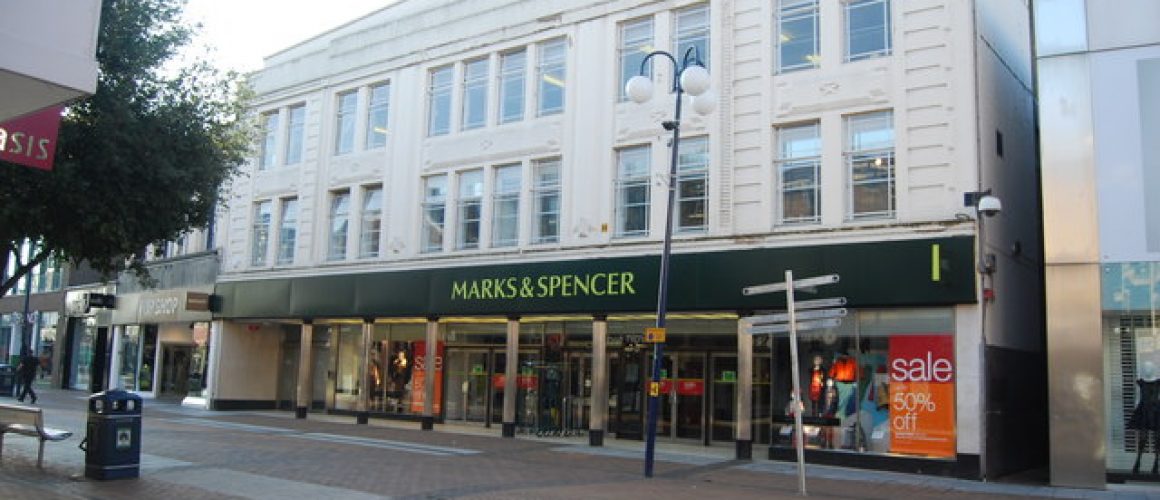The History of M&S & Where it is Now
What is M&S?
Marks & Spencer, also known as M&S, is a multinational retailer. They sell clothes, homeware, and of course food – we can’t forget those Percy Pigs.
Find out how a Yorkshireman and a Jewish immigrant banded together to turn a Leeds Market stall into one of the most recognisable names on the British High Street and worldwide.
Page Contents:
The beginning of M&S
The story of Marks & Spencer doesn’t begin on Kirkgate Market. Instead, it started in the then Russian occupied Polish town of Slonim where Michael Marks was born in 1859.
Like many Jews living in Eastern Europe around the late 19th Century, Marks had to flee his hometown due to repression from the Russians. Around 1882, he moved to Leeds.
Marks wouldn’t have spoken English and didn’t have a trade. Despite this, he soon found work for a company called Barren & Son who employed Jewish refugees.
In 1884, Marks met Isaac Dewhirst. Isaac was a business owner and ran a wholesale company.
Dewhirst decided to employ Marks. He was to sell Dewhirst’s goods around nearby Yorkshire villages and local markets including Wakefield and Castleford.
While doing this job, Marks quickly learnt English. There’s no doubt he would have learnt some Yorkshire sayings and phrases during this time.
It soon became evident that Marks had a talent for selling. Eventually, he managed to raise enough capital to rent a stall of his own at Leeds Kirkgate Market.
In 1884, Marks started trading. His stall could be called a forerunner of the modern pound shop.
Everything that he sold at the stall was the same price – one penny. Back then, this was often called a ‘penny bazaar’.
Marks sold a wide variety of goods. This ranged from wooden spoons to nails and screws.
Over time, Marks had made enough money on his Leeds stall to open others in local market halls. These included Wakefield and even some locations over the Pennines.
By 1894, his business had grown massively. This meant that Michael Marks needed a partner to help him share the workload.
As a result, he decided to approach his old boss Isaac Dewhirst. However, Isaac turned him down and pointed him in the direction of his cashier Thomas Spencer.
The Skipton born accountant had watched Marks’ business grow. When offered to become a partner, he jumped at the chance and saw the £300 he needed to secure the deal as a wise investment.
It was here that Marks & Spencer was formed. Just imagine, it could easily have been Marks & Dewhirst, but that wouldn’t quite have the same ring to it.
How M&S became what it is today
The new business partners worked well together. They both filled two important roles.
Marks had a talent for selling and business acumen. As a result, it was decided that he would continue to run the stalls.
On the other hand, Spencer would take control of the purse strings and be in charge of the supply chain. He utilised his large contact book he acquired while working for Dewhirst.
By 1897, they had 36 penny bazaars across the UK. These could be found in London, Birmingham, Cardiff and others closer to home such as Bradford, Sheffield, and Hull.
In 1903 they had become a limited company. M&S decided to leave Yorkshire and build their new headquarters in Manchester.
Their very first store opened as part of a newly developed arcade in Leeds called the Cross Arcade. Now known as Victoria Quarter, the Leeds store is located on Briggate opposite its original shop.

The beginning of the 20th Century saw the death of both partners. Spencer had retired in 1903 and passed away in July 1905 while Marks carried on working until his death in 1907.
It was now up to the next generation to carry on the good work. However, who would run it wouldn’t be decided without a fight.
For the next few years, after both Marks and Spencer’s death, a legal battle was fought. This was between Spencer’s executor of his will and Simon Marks, the son of its founder.
Eventually, Simon prevailed and became chairman in 1916 aged twenty six. However, he quickly had to adapt the business to suit the changing times.
How M&S were affected by World War I
The First World War was a time of hardship for all. It saw an increase in demand for items such as buttons, needles, and threads to mend old clothes rather than buy new ones.
M&S were conscious not to profit from the war. However, these changing times suited the business who now sold affordable goods.
By now, there were 145 shops across the UK to manage. Most of these were still penny bazaars.
The penny bazaar model was starting to become unsustainable. This was due to prices increasing through the supply chain because of the effects of being at war.
These effects meant that M&S had to increase the prices in their shops. It left its penny bazaar roots behind and by the 1920’s most items were sold for up to five shillings.
Post war fashion had changed forever. Gone were the long corsets and underskirts worn by women pre-1914.
In 1926, M&S sold its very first bra and started to sell briefs to replace the corsets and underskirts. Dresses also became shorter and easier to make and maintain.
Several new innovations were being implemented in the businesses shops. In 1930, a brand new flagship store at Marble Arch in London opened.
Cafe-bars were also rolled out across many of its larger shops. A year later in 1931, food was also beginning to appear in some of these shops.
How M&S were affected by World War II
Marks & Spencer were greatly affected during the Second World War. 100 of their shops were hit by German bombs with sixteen of these being destroyed completely.
Rationing during these years and afterwards meant that people who could afford to, chose to eat out where these rules didn’t apply. As a result, more cafe-bars were built inside the shops.
Restrictions were imposed on the amount of material that could be used in clothing. M&S had to adapt and sell garments like utility dresses which could be used for many different occasions.
The 1950’s saw an end to these restrictions imposed by war. As a result, there was a new consumer oriented society to sell to.
This decade saw big changes for M&S. They began their famous measuring services for women.
A new chairman for M&S
In 1964, Simon Marks passed away. The Chairmanship was passed to his son-in-law Israel Sieff, a Lancastr*an.
One of his first innovations was to sell fresh chickens instead of frozen ones. He also created more expansive fashion ranges which were developed to reflect the swinging sixties.
Both the 70’s and 80’s saw the business expand worldwide. This happened especially in Canada where 47 shops were opened.
Other shops opened in France, Belgium, and Hong Kong during the 1980’s. However, this expansion worldwide was met with limited success.
In Canada, the shops were seen as old fashioned catering only for older people and expats. Canadians weren’t the only ones, the UK was heading for an identity crisis too.
For a while, Marks & Spencer was struggling. They watched as profits started to fall on both sides of the Millennium.
Times were changing for M&S
M&S had prided itself in supplying most of its goods in Britain. However, rival companies and supermarkets started buying products abroad for a much cheaper price.
As a result, Marks & Spencer followed suit. This led to them losing its appeal to many of their core customers who loved the fact that they were buying quality British products.
Another factor which didn’t help M&S was that their shops didn’t accept major credit cards. They only accepted their own which wasn’t acceptable in a modern retail world.
An ill-fated TV ad campaign featuring a size 16 model stripping off and shouting “I’m normal” caused further outrage amongst the British public. It damaged M&S’s reputation further.
It wasn’t looking good for Marks & Spencer. The existence of one of Yorkshire, and Britain’s, most famous brands was under threat.
In 2004, BHS boss Richard Green attempted a £9.1 billion takeover. However, this was rejected by the company’s shareholders.
As the 2000’s progressed, so did M&S. They began to recover from those darker times at the beginning of this century.
Despite this, several small unprofitable shops, such as the one in Ripon, were closed. Their chain in Canada called white elephants were also closed.
New clothing ranges for men and women were introduced. These were called ‘Autograph’ and ‘Per Una’.
Their simply food shops have since become a success. These are slightly more expensive than other chains and have stayed at the higher end of the supermarket spectrum.
Where is M&S now?
Since then, international shops have been opened. These are in places such as Dubai, Athens, and Holland.
Marks & Spencer is once again on the rise. In total there are 959 shops in the UK and has over 78,000 employees.
In 2013, they opened a stall at Leeds Kirkgate market. They’re back to where they began but it’s doubtful they will be selling anything for a penny.
In more recent years, people have been purchasing less M&S clothing. However, their food sales have shot up dramatically.
On the 22nd of May in 2018, M&S had announced they had a new plan. This involved closing 100 shops by 2020.
In 2020, the coronavirus pandemic greatly affected Marks & Spencer. As a result, on the 18th of August that year, around 7,000 people lost their jobs.
M&S then announced a new plan to increase turnover on the 26th of May 2021. They are to close 30 shops over the next 10 years.
Despite these drawbacks, M&S continues to be a much loved business. Many people shop here for their luxurious food, fashionable clothing, and quality homeware.

